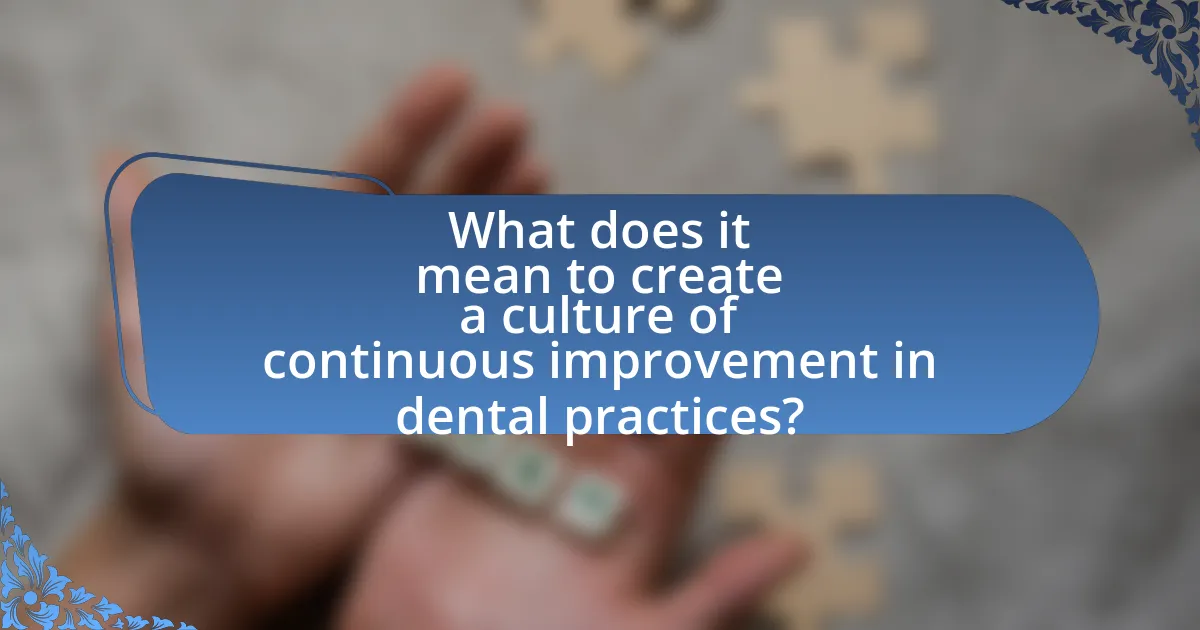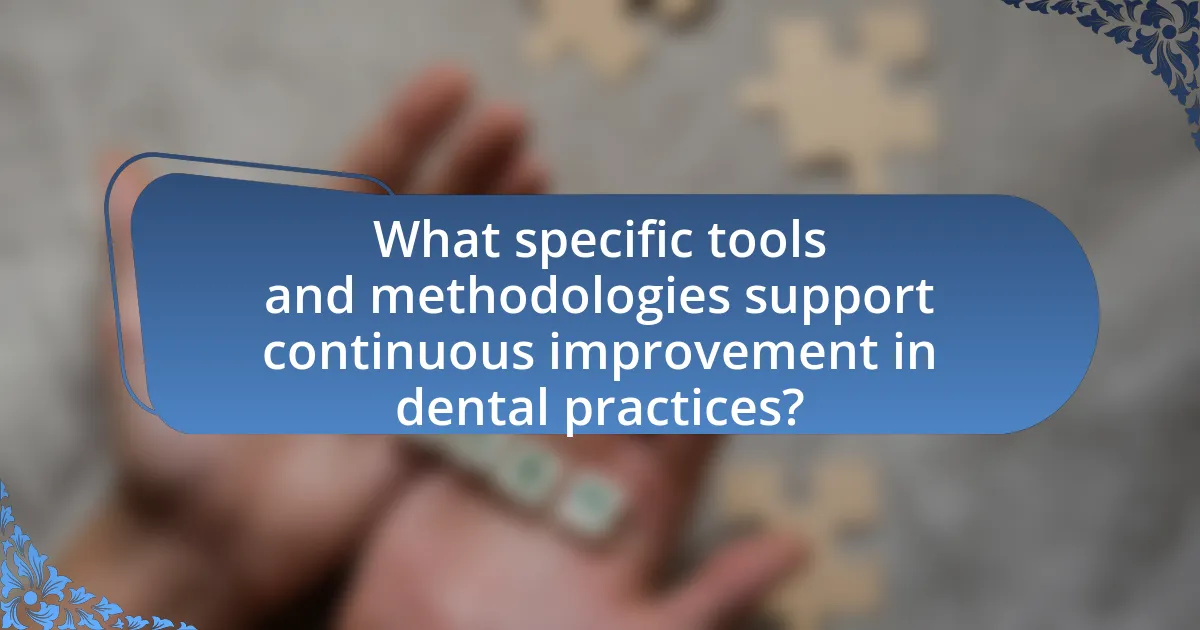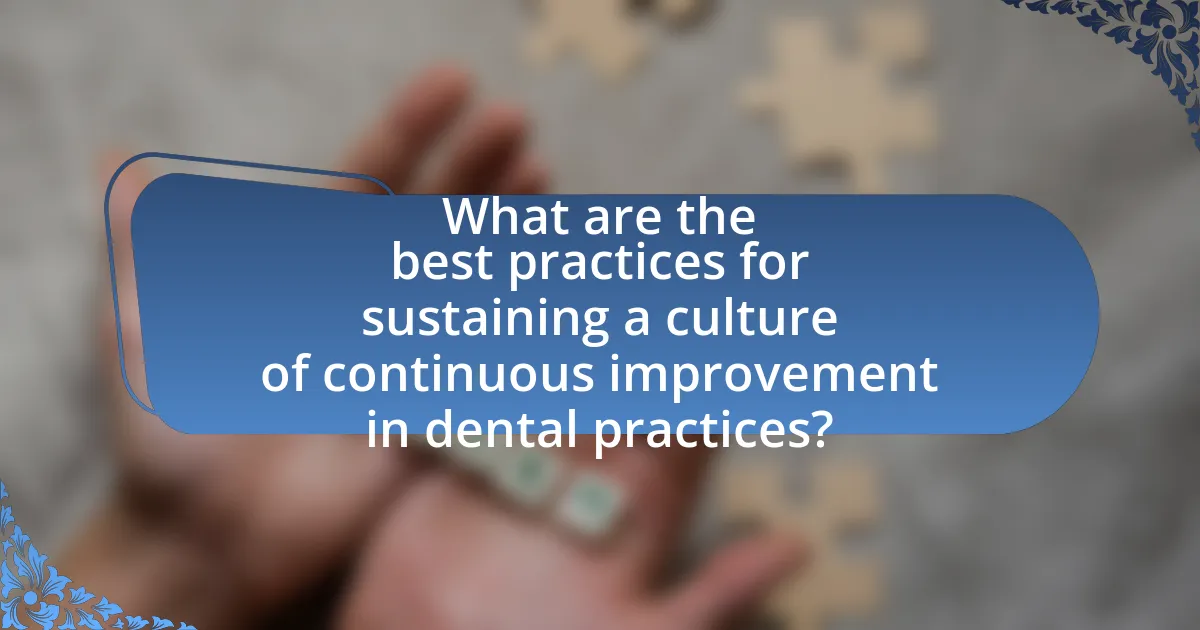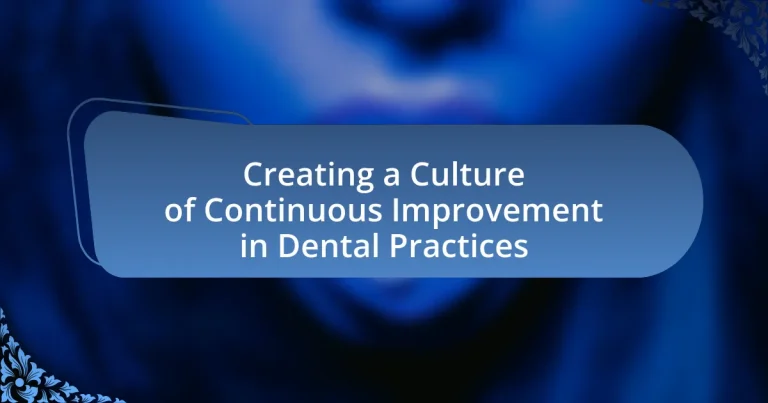Creating a culture of continuous improvement in dental practices involves establishing an environment where staff actively seek to enhance patient care, operational efficiency, and overall practice performance. Key principles include patient-centered care, data-driven decision-making, team collaboration, and ongoing education. The article outlines how continuous improvement differs from traditional management practices, the importance of leadership, and the role of technology and patient feedback in fostering this culture. It also addresses common challenges and barriers to implementation, providing actionable strategies for dental practices to effectively adopt continuous improvement methodologies such as Lean and Six Sigma, ultimately leading to better patient outcomes and staff satisfaction.

What does it mean to create a culture of continuous improvement in dental practices?
Creating a culture of continuous improvement in dental practices means fostering an environment where staff consistently seek ways to enhance patient care, operational efficiency, and overall practice performance. This involves implementing regular training, encouraging feedback from both employees and patients, and utilizing data-driven decision-making to identify areas for enhancement. Evidence shows that practices adopting continuous improvement methodologies, such as Lean or Six Sigma, report increased patient satisfaction and reduced operational costs, demonstrating the effectiveness of this approach in achieving better outcomes.
How can dental practices define continuous improvement?
Dental practices can define continuous improvement as an ongoing effort to enhance patient care, operational efficiency, and overall service quality. This definition encompasses systematic processes such as regular staff training, patient feedback collection, and the implementation of evidence-based practices. For instance, a study published in the Journal of Dental Research highlights that practices that actively solicit patient feedback and adjust their services accordingly see a measurable increase in patient satisfaction and retention rates. By integrating these strategies, dental practices can create a culture that prioritizes consistent enhancement of their services and outcomes.
What are the key principles of continuous improvement in a dental setting?
The key principles of continuous improvement in a dental setting include patient-centered care, data-driven decision-making, team collaboration, and ongoing education. Patient-centered care focuses on enhancing the patient experience and outcomes by actively involving patients in their treatment plans. Data-driven decision-making relies on the collection and analysis of performance metrics to identify areas for improvement, such as patient wait times and treatment effectiveness. Team collaboration emphasizes the importance of communication and teamwork among dental staff to foster a supportive environment for sharing ideas and best practices. Ongoing education ensures that dental professionals stay updated with the latest techniques and technologies, which contributes to improved service quality and patient satisfaction. These principles collectively create a culture of continuous improvement that enhances operational efficiency and patient care in dental practices.
How does continuous improvement differ from traditional management practices?
Continuous improvement focuses on ongoing, incremental enhancements in processes, products, or services, while traditional management practices often emphasize stability and adherence to established procedures. In continuous improvement, organizations actively seek feedback and data to identify areas for enhancement, fostering a culture of adaptability and innovation. In contrast, traditional management typically relies on hierarchical structures and fixed strategies, which can hinder responsiveness to change. Research indicates that companies employing continuous improvement methodologies, such as Lean or Six Sigma, experience higher efficiency and employee engagement compared to those adhering strictly to traditional management approaches.
Why is a culture of continuous improvement important for dental practices?
A culture of continuous improvement is important for dental practices because it enhances patient care, operational efficiency, and staff satisfaction. By consistently evaluating and refining processes, dental practices can reduce errors, improve treatment outcomes, and increase patient retention. Research indicates that practices implementing continuous improvement methodologies, such as Lean or Six Sigma, experience significant reductions in waste and increased productivity, leading to better financial performance. For instance, a study published in the Journal of Dental Research found that practices adopting continuous improvement strategies reported a 20% increase in patient satisfaction scores. This demonstrates that fostering a culture of continuous improvement directly contributes to the overall success and sustainability of dental practices.
What impact does continuous improvement have on patient care?
Continuous improvement significantly enhances patient care by systematically refining processes and practices within healthcare settings. This approach leads to increased efficiency, reduced errors, and improved patient outcomes. For instance, a study published in the Journal of Healthcare Management found that implementing continuous improvement methodologies, such as Plan-Do-Study-Act cycles, resulted in a 30% reduction in patient wait times and a 25% increase in patient satisfaction scores. These improvements not only streamline operations but also foster a culture of accountability and responsiveness to patient needs, ultimately leading to higher quality care.
How can continuous improvement enhance staff satisfaction and retention?
Continuous improvement enhances staff satisfaction and retention by fostering an environment where employees feel valued and engaged in their work. When dental practices implement continuous improvement initiatives, they encourage staff to contribute ideas for enhancing processes, which leads to a sense of ownership and investment in the practice’s success. Research indicates that organizations with strong continuous improvement cultures report higher employee engagement levels, with a Gallup study showing that engaged employees are 87% less likely to leave their organizations. This engagement translates into increased job satisfaction, as employees see their contributions making a tangible impact, thereby reducing turnover rates.
What challenges do dental practices face in implementing continuous improvement?
Dental practices face several challenges in implementing continuous improvement, primarily due to resistance to change, lack of training, and insufficient resources. Resistance to change often stems from established routines and fear of the unknown, which can hinder the adoption of new processes. Additionally, many dental professionals may lack the necessary training in continuous improvement methodologies, making it difficult to effectively implement and sustain improvements. Furthermore, limited financial and human resources can restrict the ability of practices to invest in necessary tools and training, ultimately impeding progress. These challenges are supported by studies indicating that organizational culture and employee engagement are critical factors in the successful implementation of continuous improvement initiatives in healthcare settings.
What common barriers hinder the adoption of continuous improvement practices?
Common barriers that hinder the adoption of continuous improvement practices include resistance to change, lack of leadership support, insufficient training, and inadequate resources. Resistance to change often stems from employees’ fear of the unknown or perceived threats to their job security, which can stall initiatives. Lack of leadership support is critical, as leaders must champion continuous improvement efforts to foster an environment conducive to change. Insufficient training can leave staff unprepared to implement new processes effectively, while inadequate resources, such as time and funding, can limit the ability to sustain improvement efforts. These barriers collectively impede the successful integration of continuous improvement practices in dental practices.
How can dental practices overcome resistance to change?
Dental practices can overcome resistance to change by fostering open communication and involving staff in the decision-making process. Engaging team members in discussions about changes helps to address concerns and build trust, which is essential for acceptance. Research indicates that practices that implement regular feedback mechanisms and training sessions experience a 30% increase in staff buy-in for new initiatives. Additionally, demonstrating the benefits of change through data, such as improved patient outcomes or operational efficiency, can further alleviate resistance.
How can dental practices effectively implement continuous improvement strategies?
Dental practices can effectively implement continuous improvement strategies by adopting a systematic approach that includes regular assessment of processes, staff training, and patient feedback integration. This involves establishing key performance indicators (KPIs) to measure success, conducting routine evaluations of clinical and administrative workflows, and fostering an environment where team members are encouraged to suggest improvements. Research indicates that practices that engage in continuous quality improvement see enhanced patient satisfaction and operational efficiency, as evidenced by a study published in the Journal of Dental Research, which found that practices implementing structured feedback mechanisms improved patient retention rates by 20%.
What role does leadership play in fostering a culture of continuous improvement?
Leadership plays a crucial role in fostering a culture of continuous improvement by setting a vision and demonstrating commitment to ongoing development. Effective leaders in dental practices actively promote an environment where feedback is encouraged, and innovation is valued, which directly influences team engagement and performance. Research indicates that organizations with strong leadership support for continuous improvement initiatives experience higher employee satisfaction and better patient outcomes, as seen in a study published in the Journal of Healthcare Management, which highlighted that leadership involvement significantly correlates with successful implementation of quality improvement practices.
How can staff training and development support continuous improvement initiatives?
Staff training and development can significantly support continuous improvement initiatives by equipping employees with the necessary skills and knowledge to enhance processes and services. When dental practice staff undergo regular training, they become more adept at identifying inefficiencies and implementing best practices, which directly contributes to improved patient care and operational efficiency. Research indicates that organizations that invest in employee development experience a 24% higher profit margin compared to those that do not prioritize training. This correlation highlights the importance of ongoing education in fostering a culture of continuous improvement, as trained staff are more likely to engage in innovative problem-solving and contribute to the overall success of the practice.

What specific tools and methodologies support continuous improvement in dental practices?
Specific tools and methodologies that support continuous improvement in dental practices include Lean management, Six Sigma, and Plan-Do-Study-Act (PDSA) cycles. Lean management focuses on eliminating waste and enhancing efficiency, which can lead to improved patient flow and reduced wait times. Six Sigma employs data-driven techniques to minimize variability in processes, ensuring consistent quality in patient care. PDSA cycles provide a structured approach for testing changes in practice, allowing dental teams to implement small-scale improvements and assess their impact before wider application. These methodologies have been successfully adopted in various healthcare settings, demonstrating their effectiveness in fostering a culture of continuous improvement.
What are the most effective continuous improvement methodologies for dental practices?
The most effective continuous improvement methodologies for dental practices include Lean, Six Sigma, and Plan-Do-Study-Act (PDSA). Lean focuses on eliminating waste and improving workflow efficiency, which can lead to reduced patient wait times and increased satisfaction. Six Sigma emphasizes reducing variability and defects in processes, enhancing the quality of care provided to patients. PDSA is a cyclical model that allows dental practices to test changes on a small scale, evaluate the results, and implement successful strategies more broadly. These methodologies have been validated in various healthcare settings, demonstrating their effectiveness in enhancing operational efficiency and patient outcomes.
How can Lean principles be applied in a dental practice?
Lean principles can be applied in a dental practice by streamlining processes to eliminate waste and enhance patient care. This involves mapping out patient flow, identifying bottlenecks, and implementing standardized procedures to improve efficiency. For example, reducing the time patients spend waiting for treatment can be achieved by optimizing appointment scheduling and ensuring that necessary materials are prepared in advance. Research indicates that practices implementing Lean methodologies can see a reduction in patient wait times by up to 30%, leading to increased patient satisfaction and improved operational efficiency.
What is the role of Six Sigma in improving dental practice operations?
Six Sigma plays a crucial role in improving dental practice operations by systematically identifying and eliminating inefficiencies, thereby enhancing overall service quality. By employing data-driven methodologies, dental practices can analyze processes, reduce variability, and improve patient satisfaction. For instance, a study published in the Journal of Healthcare Management demonstrated that implementing Six Sigma in healthcare settings led to a 30% reduction in patient wait times and a significant increase in treatment accuracy. This evidence supports the effectiveness of Six Sigma in fostering a culture of continuous improvement within dental practices.
How can technology facilitate continuous improvement in dental practices?
Technology facilitates continuous improvement in dental practices by streamlining operations, enhancing patient care, and enabling data-driven decision-making. For instance, electronic health records (EHR) allow for efficient patient data management, reducing errors and improving treatment outcomes. Additionally, practice management software can automate scheduling and billing processes, freeing up staff time for patient interaction and care.
Moreover, technologies such as teledentistry expand access to care, allowing practitioners to consult with patients remotely, which can lead to increased patient satisfaction and retention. Data analytics tools provide insights into practice performance, enabling dental professionals to identify areas for improvement and implement targeted strategies.
Research indicates that practices utilizing advanced technology report higher patient satisfaction rates and improved operational efficiency, demonstrating the tangible benefits of integrating technology into dental care.
What software solutions are available to support continuous improvement efforts?
Software solutions available to support continuous improvement efforts include Lean Six Sigma software, project management tools like Trello and Asana, and quality management systems such as ISO 9001 compliant software. Lean Six Sigma software helps identify inefficiencies and streamline processes, while project management tools facilitate collaboration and tracking of improvement initiatives. Quality management systems ensure compliance with industry standards and enhance overall service quality. These tools collectively enable dental practices to implement systematic improvements, measure outcomes, and foster a culture of continuous enhancement.
How can data analytics enhance decision-making in dental practices?
Data analytics can enhance decision-making in dental practices by providing actionable insights derived from patient data, treatment outcomes, and operational metrics. By analyzing trends in patient demographics and treatment efficacy, dental practices can tailor their services to meet patient needs more effectively. For instance, a study published in the Journal of Dental Research found that practices utilizing data analytics reported a 20% increase in patient retention rates due to improved personalized care strategies. Furthermore, operational data analysis can identify inefficiencies, allowing practices to optimize scheduling and resource allocation, ultimately leading to increased profitability and patient satisfaction.

What are the best practices for sustaining a culture of continuous improvement in dental practices?
The best practices for sustaining a culture of continuous improvement in dental practices include fostering open communication, implementing regular training, and utilizing patient feedback. Open communication encourages team members to share ideas and concerns, which can lead to innovative solutions and improvements. Regular training ensures that staff are up-to-date with the latest techniques and technologies, enhancing their skills and efficiency. Utilizing patient feedback allows practices to identify areas for improvement directly from those they serve, leading to better patient satisfaction and care quality. Research indicates that practices that actively engage in these strategies see a measurable increase in operational efficiency and patient outcomes.
How can dental practices measure the success of their continuous improvement initiatives?
Dental practices can measure the success of their continuous improvement initiatives through key performance indicators (KPIs) such as patient satisfaction scores, treatment outcomes, and operational efficiency metrics. By regularly collecting and analyzing data on these KPIs, practices can assess the impact of their initiatives on patient care and practice performance. For instance, a study published in the Journal of Dental Research found that practices implementing continuous improvement strategies saw a 20% increase in patient satisfaction ratings over a year. Additionally, tracking metrics like appointment wait times and treatment completion rates can provide concrete evidence of operational improvements, reinforcing the effectiveness of the initiatives.
What key performance indicators should be tracked for continuous improvement?
Key performance indicators (KPIs) that should be tracked for continuous improvement in dental practices include patient satisfaction scores, treatment acceptance rates, appointment cancellation rates, and average patient wait times. Tracking patient satisfaction scores provides insights into the quality of care and service, with studies indicating that higher satisfaction correlates with increased patient retention. Treatment acceptance rates reflect the effectiveness of communication and trust between the dental team and patients, with benchmarks suggesting that a rate above 70% is optimal for practice growth. Appointment cancellation rates, ideally below 10%, help identify operational inefficiencies, while average patient wait times should be minimized to enhance patient experience, with a target of under 15 minutes being widely accepted in the industry. These KPIs collectively enable dental practices to identify areas for improvement and implement strategies that foster a culture of continuous enhancement.
How can feedback loops be established to ensure ongoing improvement?
Feedback loops can be established to ensure ongoing improvement by implementing regular assessments and open communication channels within dental practices. Regular assessments, such as patient satisfaction surveys and staff performance reviews, provide quantifiable data that can highlight areas needing improvement. Open communication channels, including team meetings and suggestion boxes, encourage staff to share insights and experiences, fostering a culture of transparency and collaboration. Research indicates that organizations with effective feedback mechanisms experience a 14% increase in employee engagement and a 12% improvement in patient satisfaction, demonstrating the tangible benefits of these feedback loops in enhancing overall practice performance.
What role does patient feedback play in continuous improvement?
Patient feedback is essential for continuous improvement in dental practices as it provides direct insights into patient experiences and satisfaction levels. This feedback enables dental professionals to identify areas needing enhancement, such as service quality, treatment effectiveness, and patient communication. For instance, a study published in the Journal of Dental Research found that practices that actively solicited and acted on patient feedback saw a 20% increase in patient satisfaction scores over a year. By integrating patient feedback into their operational strategies, dental practices can foster a culture of continuous improvement, ultimately leading to better patient outcomes and loyalty.
How can dental practices effectively gather and utilize patient feedback?
Dental practices can effectively gather and utilize patient feedback by implementing structured surveys and follow-up communications. Structured surveys, such as post-appointment questionnaires, allow practices to collect specific insights on patient experiences, satisfaction levels, and areas for improvement. For instance, a study published in the Journal of Dental Research found that practices using patient feedback surveys saw a 20% increase in patient satisfaction scores over six months.
Additionally, dental practices can utilize feedback by analyzing the data to identify trends and make informed decisions about service enhancements. Regularly reviewing feedback helps practices adapt to patient needs, fostering a culture of continuous improvement. By integrating patient feedback into their operational strategies, dental practices can enhance patient care and build stronger relationships with their clientele.
What strategies can be employed to act on patient feedback for improvement?
To act on patient feedback for improvement, dental practices can implement systematic feedback collection, analysis, and action plans. Systematic feedback collection can involve surveys, suggestion boxes, and follow-up calls, ensuring diverse patient perspectives are captured. Analyzing this feedback allows practices to identify common themes and areas needing enhancement, such as appointment scheduling or staff communication. Action plans should be developed based on this analysis, prioritizing changes that directly address patient concerns. For instance, if multiple patients report long wait times, practices can adjust scheduling protocols or increase staffing during peak hours. This approach is supported by research indicating that practices that actively engage with patient feedback see improved patient satisfaction and retention rates.
What practical steps can dental practices take to foster a culture of continuous improvement?
Dental practices can foster a culture of continuous improvement by implementing regular training sessions for staff, encouraging open communication, and utilizing patient feedback. Regular training ensures that all team members are updated on the latest dental techniques and technologies, which enhances service quality. Open communication allows staff to share ideas and concerns, fostering a collaborative environment that promotes innovation. Utilizing patient feedback through surveys or suggestion boxes provides valuable insights into areas needing improvement, directly aligning practice operations with patient expectations. These steps are supported by research indicating that organizations with strong training and feedback mechanisms see higher employee engagement and patient satisfaction, leading to improved overall performance.
What are some actionable tips for initiating continuous improvement in a dental practice?
To initiate continuous improvement in a dental practice, implement regular team meetings to discuss performance metrics and patient feedback. These meetings foster open communication and allow staff to identify areas for enhancement. Additionally, establish a system for tracking key performance indicators (KPIs) such as patient wait times and treatment outcomes, which provides measurable data to guide improvements. Training sessions focused on new technologies and techniques can also enhance staff skills and service quality. Research indicates that practices adopting structured improvement processes see a 20% increase in patient satisfaction and operational efficiency.
How can dental teams collaborate to enhance continuous improvement efforts?
Dental teams can enhance continuous improvement efforts by implementing regular communication and feedback mechanisms. This collaboration fosters an environment where team members can share insights, identify areas for improvement, and develop solutions collectively. For instance, conducting weekly meetings allows dental professionals to discuss patient care outcomes, streamline processes, and address challenges collaboratively. Research indicates that practices with structured team meetings report higher satisfaction and improved patient outcomes, demonstrating the effectiveness of collaborative efforts in driving continuous improvement.


